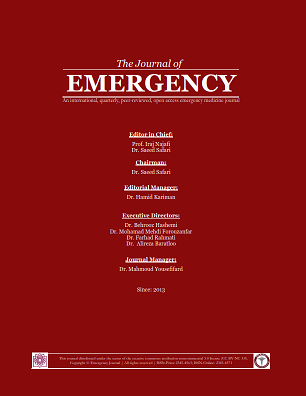Blood Lead Levels in Asymptomatic Opium Addict Patients; a Case Control Study
EMERGENCY ,
Vol. 5 No. 1 (2017),
11 January 2017
,
Page e69
https://doi.org/10.22037/emergency.v5i1.16636
Abstract
Introduction: One of the newest non-occupational sources of lead contamination is drug addiction, which has recently been addressed as a major source of lead poisoning in some countries. The present study aimed to investigate the blood lead level (BLL) of asymptomatic opium addicts.
Methods: This case-control study was conducted during a one-year period to compare BLL of three groups consisting of opium addicts, patients under methadone maintenance therapy (MMT), and healthy individuals.
Results: 99 participants with the mean age of 55.43±12.83 years were studied in three groups of 33 cases (53.5% male). The mean lead level in opium addicts, MMT and control groups were 80.30 ± 6.03 μg/L, 67.94 ± 4.42 μg/L, and 57.30±4.77 μg/L, respectively (p=0.008). There was no significant difference in BLL between MMT and healthy individuals (p=0.433) and also between opium addicts and MMT individuals (p=0.271).Oral opium abusers had significantly higher lead levels (p = 0.036). There was a significant correlation between BLL and duration of drug abuse in opium addict cases (r=0.398, p=0.022). The odds ratio of having BLL ≥ 100 in oral opium users was 2.1 (95% CI: 0.92 - 4.61; p = 0.43).
Conclusion: Based on the result of present study, when compared to healthy individuals, opium addicts, especially those who took substance orally had significantly higher levels of blood lead, and their odds of having BLL ≥ 100 was two times. Therefore, screening for BLL in opium addicts, particularly those with non-specific complaints, could be useful.
- Lead
- substance abuse treatment centers
- methadone
- opium
- heroin
- case-control studies
References
Mohammadi S, Mehrparvar A, Aghilinejad M. Appendectomy due to lead poisoning: a case-report. J Occup Med Toxicol. 2008;17(3):23.
Alarcon WA. Elevated Blood Lead Levels Among Employed Adults—United States, 1994–2012. MMWR Morb Mortal Wkly Rep. 2015;54(62):52-75.
Alarcon WA. Elevated Blood Lead Levels Among Employed Adults—United States, 1994–2012. MMWR Morb Mortal Wkly Rep. 2015; 54(62):52-75.
Golmohammadi T, Ansari M, Nikzamir A, SAFARI AR, Elahi S. The effect of maternal and fetal lead concentration on birth weight: polluted versus non-polluted areas of Iran. 2007.
Soltaninejad K, Flückiger A, Shadnia S. Opium addiction and lead poisoning. Journal of Substance Use. 2011;16(3):208-12.
Khatibi-Moghadam H, Khadem-Rezaiyan M, Afshari R. Comparison of serum and urine lead levels in opium addicts with healthy control group. Human & experimental toxicology. 2016;35(8):861-5.
Masoodi M, Zali MR, Ehsani-Ardakani MJ, Mohammad-Alizadeh AH, Aiassofi K, Aghazadeh R, et al. Abdominal pain due to lead-contaminated opium: a new source of inorganic lead poisoning in Iran. Archives of Iranian medicine. 2006 Jan;9(1):72-5. PubMed PMID: 16649384. Epub 2006/05/03. eng.
Busse F, Omidi L, Leichtle A, Windgassen M, Kluge E, Stumvoll M. Lead poisoning due to adulterated marijuana. New England journal of medicine. 2008;358(15):1641-2.
Dunbabin DW, Tallis GA, Popplewell PY, Lee RA. Lead poisoning from Indian herbal medicine (Ayurveda). The Medical Journal of Australia. 1991;157(11-12):835-6.
Norton RL, Burton BT, McGirr J. Blood lead of intravenous drug users. Journal of Toxicology: Clinical Toxicology. 1996;34(4):425-30.
Karrari P, Mehrpour O, Afshari R, Keyler D. Pattern of illicit drug use in patients referred to addiction treatment centres in Birjand, Eastern Iran. JPMA The Journal of the Pakistan Medical Association. 2013;63(6):711-6.
Ghaderi A, Vahdati-Mashhadian N, Oghabian Z, Moradi V, Afshari R, Mehrpour O. Thallium exists in opioid poisoned patients. DARU Journal of Pharmaceutical Sciences. 2015;23(1):1.
Karrari P, Mehrpour O, Abdollahi M. A systematic review on status of lead pollution and toxicity in Iran; Guidance for preventive measures. DARU Journal of Pharmaceutical Sciences. 2012;20(1):1.
Mehrpour O, Karrari P, Abdollahi M. Chronic lead poisoning in Iran; a silent disease. DARU Journal of Pharmaceutical Sciences. 2012;20(1):1.
CDC. Adult Blood Lead Epidemiology and Surveillance (ABLES). Cincinnati, OH: US Department of Health and Human Services, CDC, National Institute for Occupational Safety and Health; 2013. Available at http://www.cdc.gov/niosh/topics/ables/description.html
Mehrpour O, Sheikhazadi A, Barzegar A, Husein A, Malic C, Sheikhazadi E, Saberi-Anary SH. Comparison of Quantitative and Qualitative Dermatoglyphic Characteristics of Opium Addicts with Healthy Individuals. Addiction & health. 2016 Apr; 8(2):76..
Abbasi A, Taziki SA, AV M. The proto type of drug mis-abused of Opioids in the self-introduced addicts in Gorgan. Journal of Gorgan University of medical science. 2006;8(17):22-7.
Afghah S, Khalilian A. Survey of factors related to opioid dependency in Mazandaran province. Journal of Mazandaran University of Medical Sciences. 1996;6(12):29-35.
Malekinejad M, Vazirian M. Transition to injection amongst opioid users in Iran: implications for harm reduction. International Journal of Drug Policy. 2012;23(4):333-7.
Moayedi S FA, Mohajerani H, Seyed Am. The relationship between blood lead levels and clinical syndromes in residents of Arak, Iran. Research in Medicine. 2008;32(1):5.
Salehi H, Sayadi AR, Tashakori M, Yazdandoost R, Soltanpoor N, Sadeghi H, et al. Comparison of serum lead level in oral opium addicts with healthy control group. Archives of Iranian medicine. 2009;12(6):555-8.
Shiri R, Ansari M, Ranta M, Falah-Hassani K. Lead poisoning and recurrent abdominal pain. Industrial health. 2007;45(3):494-6.
Farzin L, Amiri M, Shams H, Faghih MAA, Moassesi ME. Blood levels of lead, cadmium, and mercury in residents of Tehran. Biological trace element research. 2008;123(1-3):14-26.
Abbasi MMH, Ansari M, Shahesmaeili A, Qaraie A. Lead serum levels in opium-dependent individuals. Addiction & health. 2009;1(2):106.
Hashemi Domeneh B, Tavakoli N, Jafari N. Blood lead level in opium dependents and its association with anemia: A cross-sectional study from the capital of Iran. 2014. 2014;19(10).
- Abstract Viewed: 1131 times
- PDF Downloaded: 407 times
